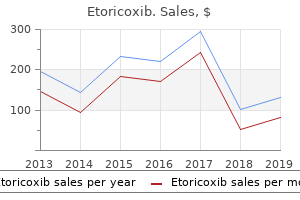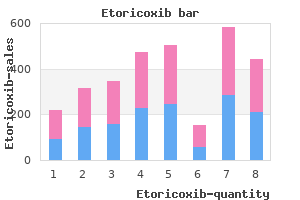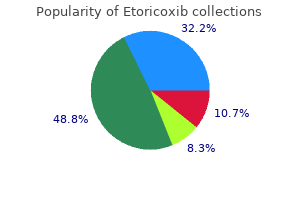"Order etoricoxib 90mg without prescription, rheumatoid arthritis books."
By: Bob Atkins
- Emeritus Professor, Epidemiology & Prev Med Alfred Hospital
https://research.monash.edu/en/persons/bob-atkins
Bluish tint of the skin: displays the presence of three5 g/dL of decreased Hgb in the blood What should the O2 saturation be for an toddler with polycythemia to arthritis pain characteristics buy 120 mg etoricoxib otc reveal cyanosis? Intrauterine or delivery-related problems may point out sepsis rheumatoid arthritis diet recipes free buy etoricoxib 120 mg without prescription, asphyxia rheumatoid arthritis supplements generic 90mg etoricoxib with amex, or pulmonary insult as causes of cyanosis List three significant findings on medical examination arthritis in back and neck purchase etoricoxib 120 mg without prescription. Heart murmurs, absent distal pulses, respiratory misery Why is a chest radiograph necessary? Failure to reveal an increase of PaO2 >a hundred mm Hg in response to oxygen suggests a cardiac rather than pulmonary etiologic issue. It may point out methemoglobinemia What situation may trigger a 510% difference in O2 saturation between the arms and legs? Prostaglandin E1 infusion may improve oxygenation in the toddler with cyanotic heart disease or perfusion in the toddler with left-sided obstructive lesions. Primary lung disease List three types of restrictive (poor lung compliance) conditions. Pneumonia, surfactant deficiency, malformation of the lung or chest wall Give an example of a type of obstructive (regular compliance) situation. Aspiration syndromes, for instance, aspiration of blood, amniotic fluid, meconium or gastric contents List 12 different common causes of respiratory misery. Elbows and knees flexed; palms most often in the fisted place For a premature new child? Conditions which are genetic or acquired in the intrauterine environment or during the delivery process. Neuromuscular conditions may be at any stage: cerebral cortex to peripheral nerve to neuromuscular junction to muscle. Myotonic dystrophy and different muscular dystrophies Why is family history necessary? In addition, infants with congenital myotonic dystrophy may present no medical or electrical indicators of myotonia; however, usually the mom will List 5 necessary laboratory studies. Neurologists and genetic consultants provide workups of particular congenital metabolic disorders What is the prognosis? Symptoms previous the attack (palpation, chest, dizziness) the length of the attack Associated symptoms (dizziness, visible changes, nausea) Common conditions of syncope: Vasovagal syncope: is by far the commonest reason for syncope amongst youngsters. Precipitating occasions can embrace standing or stress (physical or emotional) and even swallowing, hair grooming and micturition. The trigger is normally due to an emotional insult such as pain, anger or concern and the child may be cyanotic or pallid. Breath holding spells normally observe a benign course and are expected to stop by the age of 5. Toxic publicity: Exposure to toxins may end up in decreased cardiac output or lack of consciousness brought on by quite a few toxins such as barbiturates, tricyclic antidepressants, and phenothiazines. Noticed in the presence of an audience, this situation lacks hemodynamic or autonomic changes that may be extended however hardly ever end in damage. The murmur of mitral stenosis is heard extra clearly if child lies in supine place and turns in the direction of left Listen for the following: 1. Normal heart sounds: o 1st heart sound for intensity (greatest at apex) o 2nd heart sound (greatest at pulmonary area) for intensity and splitting 2. Neonates obstructed (duct-dependent) systemic circulation: Hypoplastic left heart syndrome Critical aortic valve stenosis Severe coarctation of the aorta Interruption of the aortic arch 2. Infants (excessive pulmonary blood circulate) Ventricular septal defect Atrioventricular septal defect Large persistent ductus arteriosus three. Older youngsters and adolescents (proper or left heart failure) Eisenmenger syndrome (proper heart failure only) Rheumatic heart disease cardiomyopathy What is included in the Investigations? Consequently, the first precedence is acquiring a good understanding of the etiology. Hoarseness: Age and time of onset length of symptoms rate of onset Associated symptoms: (respiratory misery. Fever, hemangiomas, sore throat) extended loud crying or screaming (vocal cord polyps or nodules) Trauma, earlier surgery, Intubation (subglottic stenosis) Prior episodes of croup, upper respiratory tract infections, Neurologic disorders Exacerbating or relieving components.

The area to arthritis in the back ribs buy 60 mg etoricoxib free shipping be treated will both be the cranial or entrance half of the abdomen or the caudal or back half of the abdomen arthritis medication for dogs review cheap etoricoxib 60mg with visa. If the world to arthritis diet plan 2011 60 mg etoricoxib for sale be treated is the small gut rheumatoid arthritis in your back buy 120mg etoricoxib amex, large gut, colon, or uterus, the caudal or back half of the abdomen is to be treated. In a toy-size dog or a cat, the entire abdomen may be treated with a big Assisi Loop. The Loop may be positioned across the affected person if the scale of the affected person and the scale of the Assisi Loop are acceptable for this positioning to be utilized. One Assisi Loop can be utilized on 37 the two sides consecutively, however there should be 2 hours in between classes for optimum battery longevity. If symptoms recur, using the Assisi Loop 2-four instances every day at preliminary presentation may reduce severity or length of the symptoms. Small Assisi Loops can be utilized for as much as Beagle-sized pets when treating just one hip. Dogs larger than a Beagle should use a big Assisi Loop and one hip at a time might want to be treated. If each hips are to be treated, there must be a two-hour time span between the remedies to optimize the battery lifetime of the unit, or two units could also be used simultaneously. To treat each hips simultaneously on a small pet, place the Loop across the pelvis in order that the Assisi Loop crosses over the hip joints. When treating one hip at a time, the Assisi Loop heart is positioned excessive of the femur (thigh bone) in order that the hip joint can receive most remedy. Attach the Assisi Loop with two Velcro straps to keep the Loop position with the center of the Assisi Loop over the hip. A small or large Assisi Loop can be utilized to treat the hip area of the pet relying on the scale of the pet. Larger Assisi Loops can be utilized to treat each hips simultaneously on small pets when positioned appropriately. To treat each hips simultaneously on a small pet, the Loop should be positioned across the pelvis in order that the Assisi Loop crosses over the hip joints. When treating one hip at a time, the Assisi Loop heart is positioned excessive of the femur (thigh bone) so the hip joint can receive most remedy. Long-term persistent situations may require as much as 41 3-6 weeks earlier than tapering could be acceptable. It is frequent to utilize the Assisi Loop after long walks or uncommon activity when persistent hip points exist. Position the pet lying down both flat on the bottom or up on their elbows with their rear limbs out to one facet. Identify the hock/tarsal joint(s) and place one or each joints within the therapy area. Lay the Assisi Loop over the world or if each hocks are to be treated then place the Loop between the hocks in order to treat them simultaneously. Long-term persistent situations may require as much as 3-6 weeks earlier than tapering could be acceptable. It is frequent to utilize the Assisi Loop after long walks or uncommon activity when persistent hock points exist. The pet may be treated with an Assisi Loop positioned on its back, round its abdomen, or from the facet. Positioning of the Assisi Loop on the back or across the abdomen are the preferred positions. Attach the Assisi Loop with two Velcro straps to keep the Loop position with the center of the Assisi Loop over the Kidneys. In instances of severe disease use the unit 3-four instances every day, if potential, until medical signs have resolved. A small or large Assisi Loop can be utilized to treat the knee area of the pet relying on the positioning of the Loop and size of the pet. Small Assisi Loops can be utilized for as much as Beaglesized pets when treating the pet from inside or exterior of the knee. There should be a minimum of two hours between remedies for optimum nitric oxide enhancement.
Etoricoxib 90 mg mastercard. Cervical Spondylosis (Arthritis of the Neck) / Neck Pain & Pinched Nerve / Dr Mandell.

It can detect the early changes of bone marrow oedema and osteonecrosis before another imaging modality tylenol arthritis pain gel caps quality etoricoxib 90 mg. Additional use of fat suppression sequences determines the extent of peri-lesional oedema and intravenous distinction will reveal the active a part of the tumour arthritis in neck how to treat discount 60mg etoricoxib mastercard. Intravenous distinction is used to arthritis hip purchase etoricoxib 90mg on line distinguish vascularized from avascular tissue arthritis medication that starts with m order 90mg etoricoxib with mastercard. In the ankle, it offers the way in which to reveal anterolateral impingement and assess the integrity of the capsular ligaments. Fat suppression sequences allow highlighting of irregular water, which is especially helpful in orthopaedics when assessing both soft tissue and bone marrow oedema. Indirect arthrography Gadolinium compounds administered intravenously shall be secreted by way of joint synovium into joint effusions leading to oblique arthrography. Direct arthrography Direct puncture of joints underneath picture steerage with a solution containing dilute gadolinium (1:200 concentration) is routinely performed. However, the data obtained is very operator dependent, counting on the expertise and interpretation of the technician. This is similar precept as the change in frequency of the noise from a passing fire engine when travelling in direction of and then away from an observer. Abnormal elevated blood move could be noticed in areas of irritation or in aggressive tumours. Depending on their structure, completely different tissues are referred to as extremely echogenic, mildly echogenic or echo-free. Real-time display on a monitor offers a dynamic picture, which is extra helpful than the usual static pictures. The low background radioactivity means that any website of elevated uptake is instantly seen. Normally, within the early perfusion section the vascular soft tissues across the joints produce the sharpest (most active) picture; three hours later this activity has light and the bone outlines are proven extra clearly, the best activity showing within the cancellous tissue at the ends of the lengthy bones. Ultrasound is commonly used for assessing tendons and diagnosing conditions such as tendinitis and partial or complete tears. The rotator cuff, patellar ligament, quadriceps tendon, Achilles tendon, flexor tendons and peroneal tendons are typical examples. The same method is used extensively for guiding needle placement in diagnostic and therapeutic joint and soft-tissue injections. One benefit is that the whole physique could be imaged to look for multiple sites of pathology (occult metastases, multi-focal infection and multiple occult fractures). It can also be one of the solely methods to give information about physiological activity within the tissues being examined (essentially osteoblastic activity). However, the method carries a big radiation burden (equivalent to roughly 200 chest x-rays) and the images yielded make anatomical localization difficult (poor spatial resolution). Four forms of abnormality are seen: Increased activity within the perfusion section this is because of matory cells and has been used to determine sites of hidden infection: for instance, within the investigation of prosthetic loosening after joint alternative. Decreased activity within the perfusion section this is a lot less frequent and signifies native vascular insufficiency. Increased activity within the delayed bone section this could possibly be due both to excessive isotope uptake within the osseous extracellular fluid or to extra avid incorporation into newly forming bone tissue; both can be likely in a fracture, implant loosening, infection, a local tumour or therapeutic after necrosis, and nothing within the bone scan itself distinguishes between these conditions. Preferential uptake in areas of infection is expected, thereby hoping to distinguish sites of active infection from chronic irritation. For example, white cell uptake is extra more likely to be seen with an infected complete hip alternative as opposed to mechanical loosening. The scintigraphic appearances in these conditions are described within the related chapters. Positron-emitting isotopes with quick half-lives are produced on website at specialist centres using a cyclotron. The basic loss of bone density accentuates the cortical outlines of the vertebral physique finish-plates.

If doubt exists (and it usually does) a plaster jacket should be worn for three months; the latest fracture might be part of spontaneously rheumatoid arthritis headache buy 90 mg etoricoxib mastercard. On plain x-rays the decrease limits of regular for the lumbar vertebrae are usually taken as 15 mm for the anteroposterior and 20 mm for the transverse diameters (Eisenstein arthritis pain and weather purchase etoricoxib 120mg without prescription, 1977; 1983) arthritis in older dogs etoricoxib 60 mg lowest price. Treatment Conservative measures arthritis wrist exercises order etoricoxib 120mg overnight delivery, including instruction in spinal posture, might suffice. Most patients are ready to put up with their symptoms and easily avoid uncomfortable postures. If discomfort is marked and actions corresponding to standing and walking are severely restricted, operative decompression is sort of at all times successful. A large laminotomy with flavectomy, medial facetectomy and discectomy is performed at each related stage and on each related facet, if necessary extending over a number of levels and laterally to clear the nerve root canals. This relieves the leg ache, but not the again ache, and occasionally the surgery truly will increase spondylolisthesis and again ache; consequently in patients under 60 the operation is sometimes combined with spinal fusion (Eisenstein, 2002). The affected person might favor walking uphill, which flexes the spine (and maximizes the spinal canal capacity), to downhill, which extends it. The affected person typically has a earlier history of disc prolapse, continual backache or spinal operation. Examination, especially after getting the affected person to reproduce the symptoms by walking, might (not often) show neurological deficit in the decrease limbs. Intact pedal pulses would affirm the claudication as spinal quite than arterial, but watch out for the older affected person who might have each spinal and arterial claudication. Transient backache following muscular exercise Imaging X-rays will usually show features of disc degeneration and proliferative osteoarthritis or degenerative spondylolisthesis. This suggests a simple again strain that may reply to a short period of rest followed by progressively increasing train. People with thoracic kyphosis (of whatever origin), or fastened flexion of the hip, are significantly susceptible to again strain as a result of they have a tendency to compensate for the deformity by holding the lumbosacral spine in hyperlordosis. In young individuals (these under the age of 20) you will need to exclude infection and spondylolisthesis; each produce recognizable x-ray modifications. Patients aged 20forty years usually tend to have an acute disc prolapse: diagnostic features are: (1) a history of a lifting strain, (2) unequivocal sciatic rigidity; (three) neurological symptoms and signs. Elderly patients might have osteoporotic compression fractures, but metastatic disease and myeloma should be excluded. Patients of almost any age might complain of recurrent backache following exertion or lifting actions and that is relieved by rest. Features of disc prolapse are absent but there could also be a history of acute sciatica in the past. In the process, problems corresponding to ankylosing spondylitis, continual infection, myelomatosis and other bone illnesses should be excluded by applicable imaging and blood investigations. Patients with these features are unlikely to reply to usually aged over 50 and may give a history of earlier, longstanding again bother. Spinal osteoporosis in middle-aged males is pathological and calls for a full battery of tests to exclude main problems corresponding to myelomatosis, carcinomatosis, hyperthyroidism, gonadal insufficiency, alcoholism or corticosteroid usage. In upright man the lumbar phase is lordotic and the column acts like a crane; the paravertebral muscular tissues are the cables that counterbalance any weight carried anteriorly. The resultant force, which passes by way of the nucleus pulposus of the lowest lumbar disc, is therefore much larger than if the column have been loaded directly over its centre; even at rest, tonic contraction of the posterior muscular tissues balances the trunk, so the lumbar spine is at all times loaded. Nachemson and Morris (1964) measured the intradiscal pressure in volunteers during varied actions and found it as high as 1015 kg/cm2 while sitting, about 30 per cent much less on standing upright and 50 per cent much less on mendacity down. Leaning forward or carrying a weight produces much higher pressures, though when a heavy weight is lifted breathing stops and the belly muscular tissues contract, turning the trunk right into a tightly inflated bag that cushions the force anteriorly in opposition to the pelvis. Lying supine with the legs straight tilts the pelvic brim forwards; the lumbar spine compensates by increasing its lordosis. If the hips are unable to prolong totally (fastened flexion deformity), the lumbar lordosis will increase still extra until the decrease limbs lie flat and the flexion deformity is masked. The column features like a crane, the weight in front of the spine being counterbalanced by contraction of the posterior muscular tissues. In childhood these are coated by cartilage, which contributes to vertebral growth. Later the peripheral rim ossifies and fuses with the body, but the central area remains as a skinny layer of cartilage adherent to the intervertebral disc. If the physicochemical state of the nucleus pulposus is regular, the disc can withstand almost any load that the muscular tissues can support; if it is abnormal, even small will increase in force can produce adequate stress to rupture the annulus.
References:
- https://www.ashnha.com/wp-content/uploads/2015/05/ACP-URI-guidelines-1.pdf
- http://www.who.int/selection_medicines/committees/expert/21/applications/s6_paed_antibiotics_appendix4_sepsis.pdf
- https://www.chospab.es/biblioteca/DOCUMENTOS/Color_Atlas_of_Hematology_Practical_and_Clinical_Diagnosis_2004_Thieme.pdf
- https://wedocs.unep.org/bitstream/handle/20.500.11822/17554/FINAL_%20UNEA2_Inf%20doc%2028.pdf?sequence=2&isAllowed=y
- https://www.beverlyhospital.org/media/314110/1%20%20garnick%20intro%20to%20cancer%206%20oct%2009.pdf

